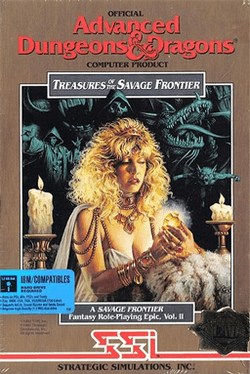Treasures of the Savage Frontier
| Treasures of the Savage Frontier | |
|---|---|
 | |
| Developer(s) | Stormfront Studios |
| Publisher(s) | Strategic Simulations, Inc., WizardWorks Software |
| Composer(s) | Linwood Taylor |
| Series | Gold Box |
| Engine | Gold Box |
| Platform(s) | Amiga, MS-DOS |
| Release date(s) |
|
| Genre(s) | Role-playing game, Tactical RPG |
| Mode(s) | Single player |
Treasures of the Savage Frontier (1992) is a Gold Box Dungeons and Dragons role-playing video game. It was developed by Stormfront Studios and published by SSI for the Amiga and DOS.
Development
When SSI began work on the Dark Sun game engine in 1989 after the completion of The Secret of the Silver Blades, they passed responsibility for continuing the Forgotten Realms Gold Box games to Stormfront. SSI had planned to do only one more Gold Box game (Gateway to the Savage Frontier) before retiring the series in favor of the Dark Sun engine, but when Dark Sun was delayed and Gateway went to #1 on the charts they asked Stormfront for a sequel.
Designers Don Daglow, Mark Buchignani, Mark Manyen, and David Bunnett recognized that the Gold Box engine was past its prime and needed some kind of story or character enhancements to feel like a new game and not a tired sequel.
Although they added many small enhancements to the game in addition to its all-new story, the largest feature was the first-ever option for either of two NPCs to fall in love with a player character. The sophisticated AI (for its time) tracked the player's actions in the game, much as the modern game Fable charts the player's actions as good or evil. If the player's actions matched the values of the NPC there was a chance they could fall in love.
Plot overview

A few weeks after the events of Gateway to the Savage Frontier, the mage Amelior Aminitas magically summons the party (by now called the "Heroes of Ascore") to eliminate the (apparently) last remaining troops of the Zhentarim from the dwarven city of Llorkh.
Afterwards, the party is given a seemingly simple mission – to protect ambassadors of the "Lord's Alliance", which holds together the different cities of the frontier. However, the ambassadors are kidnapped, the Zhentarim and its allies (the Kraken Society and the Hosttower of the Arcane) plot to break up the alliance to conquer the region, and the party is framed as traitors.
Much of the game is devoted to having the players attempt to clear their names (usually done by completing a mission in each town of the Lord's Alliance) and alert the alliance's leaders of the plot. The final mission (which does not necessarily fit in the overall plotline) involves retrieving a treasure held by a dragon.
To uncover the plot, the player has to collect two different sets of items:
- Three different colors of crystals held by one of the three enemy groups (the Zhentarim, the Kraken, and the Hosttower). This can only be done by, in melee battles, carefully selecting and attacking different enemies in the right order.
- "Lucky papers" from each city in the game. Nominally good luck charms, when combined with the crystals, these papers spell out the entire enemy plot.
Gameplay
Treasures of the Savage Frontier allows characters up to level 12.[1] Depending on the player character's actions, certain non-player characters can fall in love with him.[1] The game allows the option to utilize allied forces, which increases the number of combatants.[1]
The game's principal technical enhancement to the aging Gold Box engine is the addition of weather to wilderness play. Combat encounters in the snow restrict character movement and add variety to the game.
Reception
Treasures of the Savage Frontier was reviewed in 1992 in Dragon #184 by Hartley, Patricia, and Kirk Lesser in "The Role of Computers" column. The reviewers gave the game 4 out of 5 stars.[2] Computer Gaming World in 1993 stated that the game was "a yawner" and "almost indistinguishable from" other Gold Box games".[3]
According to GameSpy, "interest in the Gold Box-style of games waned quickly after its release. For what it's worth, it was a memorable enough closing for the series, and it is remembered as one of the more polished and accomplished of the games".[4]
See also
References
- 1 2 3 Tresca, Michael J. (2010), The Evolution of Fantasy Role-Playing Games, McFarland, p. 143, ISBN 078645895X
- ↑ Lesser, Hartley; Lesser, Patricia & Lesser, Kirk (August 1992). "The Role of Computers". Dragon (184): 57–64.
- ↑ Scorpia (October 1993). "Scorpia's Magic Scroll Of Games". Computer Gaming World. pp. 34–50. Retrieved 25 March 2016.
- ↑ Rausch, Allen; Lopez, Miguel (August 16, 2004). "A History of D&D Video Games - Part II". Game Spy.